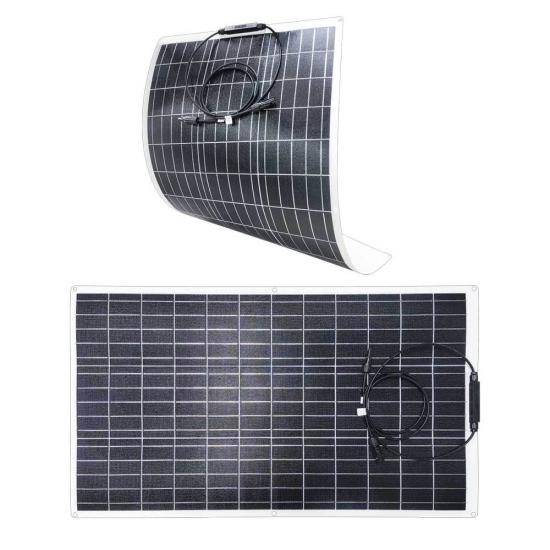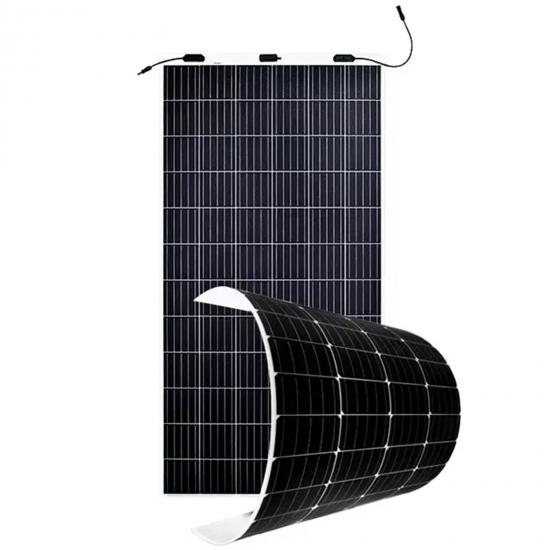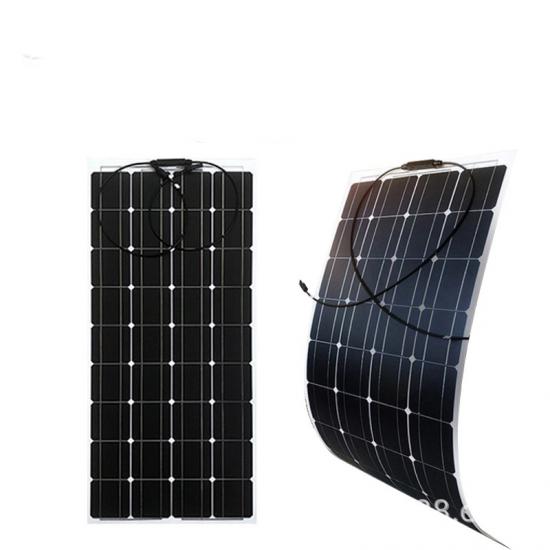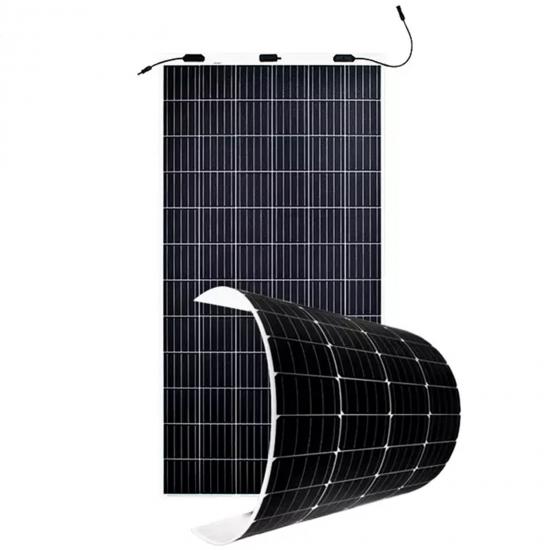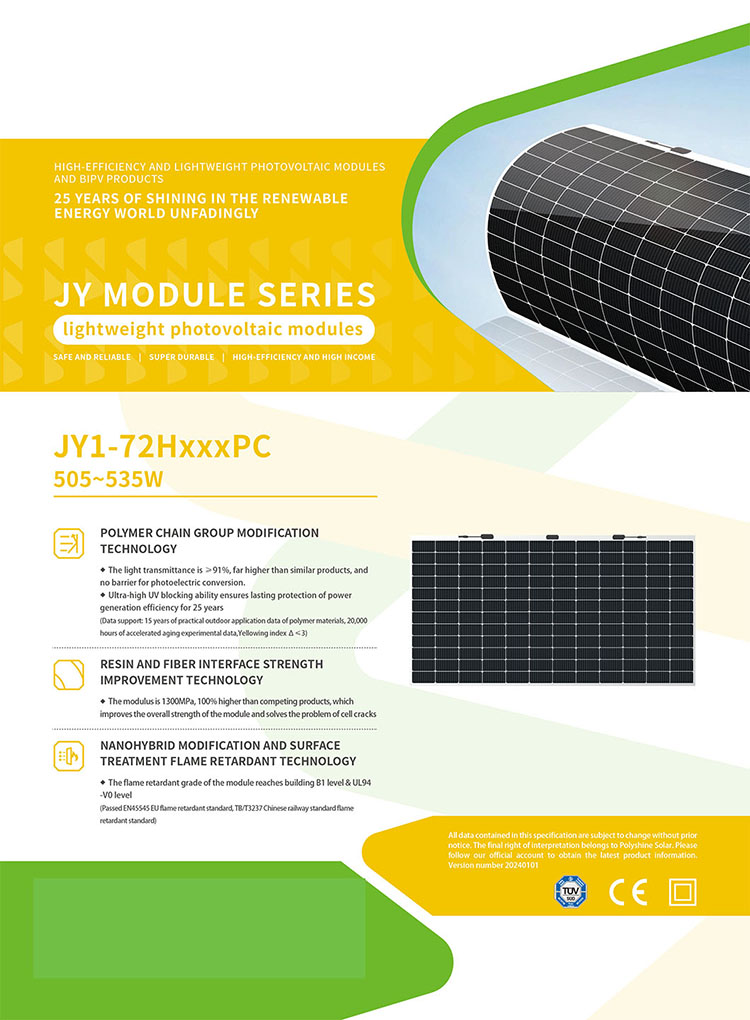
PARAMETER
TYPICAL ELECTRICAL CHARACTERISTICS
TYPICAL ELECTRICAL CHARACTERISTICS
AT STANDARD TEST CONDITIONS(STC)
STC:AM=1.5,irradiance1000W/m²,Component temperature25℃
AT STANDARD TEST CONDITIONS(STC)
STC:AM=1.5,irradiance1000W/m²,Component temperature25℃
Typical Type
Unit
JY1-72H505PC
JY1-72H510PC
JY1-72H515PC
JY1-72H520PC
JY1-72H525PC
JY1-72H530PC
JY1-t72H535PC
Typical Type
Unit
JY1-72H505PC
JY1-72H510PC
JY1-72H515PC
JY1-72H520PC
JY1-72H525PC
JY1-72H530PC
JY1-t72H535PC
Max-Power(Pm)
W
505
510
515
520
525
530
535
Max-Power(Pm)
W
505
510
515
520
525
530
535
Power Tolerance
W
0~+5W
Power Tolerance
W
0~+5W
Max-Operating Voltage(Vm)
39.80
39.95
40.10
40.24
40.40
40.55
40.70
Max-Operating Voltage(Vm)
39.80
39.95
40.10
40.24
40.40
40.55
40.70
Max-OperatingCurrent(m)
A
12.70
12.78
12.86
12.94
13.01
13.09
13.16
Max-OperatingCurrent(m)
A
12.70
12.78
12.86
12.94
13.01
13.09
13.16
OpenCircuitVoltage(Voc)
V
47.50
47.70
47.90
48.10
48.30
48.50
48.70
OpenCircuitVoltage(Voc)
V
47.50
47.70
47.90
48.10
48.30
48.50
48.70
Short Circuit Current(isc)
A
13.47
13.52
13.57
13.62
13.67
13.72
13.77
Short Circuit Current(isc)
A
13.47
13.52
13.57
13.62
13.67
13.72
13.77
Module Efficiency(nm)
%
19.0
19.2
19.3
19.5
19.7
19.9
20.1
Module Efficiency(nm)
%
19.0
19.2
19.3
19.5
19.7
19.9
20.1
ELECTRICAL
CHARACTERISTICS AT NOMINAL MODULE
ELECTRICAL
CHARACTERISTICS AT NOMINAL MODULE
OPERATING
TEMPERATURE(NMOT)
NMOT:irradiance 800W/m²,ambienttemperature20℃,wind speed¹m/s
OPERATING
TEMPERATURE(NMOT)
NMOT:irradiance 800W/m²,ambienttemperature20℃,wind speed¹m/s
Typical Type
Unit
JY1-72H505PC
JY1-72H510PC
JY1-72H515PC
JY1-72H520PC
JY1-72H525PC
JY1-72H530PC
JY1-t72H535PC
Typical Type
Unit
JY1-72H505PC
JY1-72H510PC
JY1-72H515PC
JY1-72H520PC
JY1-72H525PC
JY1-72H530PC
JY1-t72H535PC
Max-Power(Pm)
W
381
385
389
393
397
401
405
Max-Power(Pm)
W
381
385
389
393
397
401
405
Max-Perating Voltage(Vm)
V
36.98
37.13
37.27
37.43
37.56
37.71
37.86
Max-Perating Voltage(Vm)
V
36.98
37.13
37.27
37.43
37.56
37.71
37.86
Max-OperatingCurrent(Im)
A
10.31
10.38
10.45
10.51
10.58
10.63
10.70
Max-OperatingCurrent(Im)
A
10.31
10.38
10.45
10.51
10.58
10.63
10.70
Open-Circuitvoltage(Voc)
V
44.70
44.90
45.10
45.30
45.50
45.70
45.90
Open-Circuitvoltage(Voc)
V
44.70
44.90
45.10
45.30
45.50
45.70
45.90
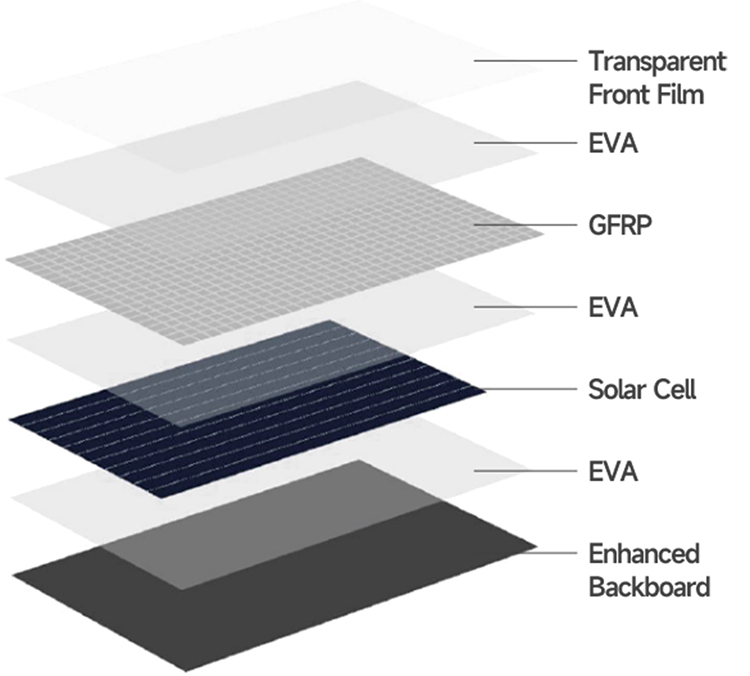
ADVANTAGE
Traditional modules cannot meet the needs of modern photovoltaic integrated buildings in terms of lightweight, flexibility, functional integration, and overall performance.
·Limited Load heavyweight, bracket installation, high roof load requirements
·Safety Risk risk of self-explosion (3‰ )
·Additional costs steel structure/bracket costs, labor costs due to complex construction
·Insufficient Shock Resistance the glass module is fragile and has poor shock resistance
·Aesthetic Shortcomings single color, single shape, poor adaptability
·LIGHTEROnly 30% of the weight of traditional modules, solving the problem of insufficient load on existing roofs
·MORE FLEXIBLEIt can be better integrated into architectural design, provide more diverse appearance and integration solutions, and adapt to different curved surfaces and shapes, so that photovoltaic systems can be perfectly integrated with buildings and reduce design restrictions.
·SHINING GREEN ENERGY WORLD Through the research and technological iteration of encapsulation materials, we have solved the insufficient light transmission and weather resistance of other ordinary lightweight modules and achieved higher and more stable power generation efficiency.
Flexible solar panels differ quite from rigid, rectangular, glass-encased standard solar panels typically found on rooftops. Rather, flexible solar panels come in all shapes and sizes and are expected to be used in a greater number of situations than standard panels Whereas portable solar panels contain solar cells mounted in a lightweight, often plastic frame and thin-film panels are made of materials like copper, selenium, and gallium, flexible and standard solar panels use solar wafers to convert sunlight to electricity. Most often, flexible panels use wafers made from silicon, though they are far thinner than those in standard panels-as thin as merely a few micrometers in width. Whereas standard panels are sandwiched between layers of glass, flexible panels are placed between layers of protective plastic.
Flexible solar panels differ quite from rigid, rectangular, glass-encased standard solar panels typically found on rooftops. Rather, flexible solar panels come in all shapes and sizes and are expected to be used in a greater number of situations than standard panels Whereas portable solar panels contain solar cells mounted in a lightweight, often plastic frame and thin-film panels are made of materials like copper, selenium, and gallium, flexible and standard solar panels use solar wafers to convert sunlight to electricity. Most often, flexible panels use wafers made from silicon, though they are far thinner than those in standard panels-as thin as merely a few micrometers in width. Whereas standard panels are sandwiched between layers of glass, flexible panels are placed between layers of protective plastic.
Off-grid or hybrid optional 6KW inverter, Max 3pcs in parallel Grade A battery cells, up to 6000+ cycles 5.5KWh battery, Max 12pcs in parallel Easy to install, combined freely BMS & battery capacity auto-sense WiFi/GPRS remote monitoring (optional)
Characters Transformerless with three level topology Max efficiency up to 98.6% Dual MPPT inputs accommodating wide voltage range Compact structure design Complete protection function such as anti-islanding, short circuit, overload Easy installation and free maintenance WiFi or GPRS (optional) communication Component brands Specification Model No ST17KTL ST20KTL ST25KTL DC side/Input parameters Max. DC power [W] 18500 22000 25000 Max. DC voltage [Vdc] 1000Vdc. 1000Vdc. 1000Vdc Min. System start/Shut down voltage [Vdc] 250 250 250 MPPT voltage range[Vdc] 250~850 250~850 250~850 Max. input current [A] 25A*2 25A*2 25A*2 Number of MPP trackers 2 2 2 Strings per MPP tracker 2 2 2 AC side/output parameters Nominal output power [W] 17000 20000 25000 Maximum output power [W] 18500 22000 27000 Nominal output voltage/range [V] 400V/ 280-490V(adjustable) AC grid frequency/range [Hz] 50Hz,60Hz(auto-selection) / 44Hz-55Hz; 54Hz-65Hz Maximum output current [A] 25 30 36 AC connection(with PE) 3W/N/PE 3W/N/PE 3W/N/PE Current distortion(THDi) [%] <1.5 <1.5 <1.5 Power factor [%] >99.95 >99.95 >99.95 Efficiency Maximum conversion efficiency[%] 98.5 98.6 98.8 European efficiency[%] 98.1 98.2 98.3 MPPT efficiency[%] 99.9 99.9 99.9 Safety and protection yes DC reverse-polarity protection yes Anti-islanding / Overvoltage protection yes Short circuit protection yes Leakage current protection yes Grid monitoring / Ground fault monitoring yes DC/AC side varistors(thermally protected) yes General Parameters Dimension(L/W/H)[mm] 505*525*245 Weight (kg) 37 Embedded DC Switch Optional Night power consumption[W] <0.2 Isolation type Transformerless Protection degree IP65 according to IEC60529 Operation temperature[ºC] -25 ~ 60 Cooling concept Natural convection Acoustic noise level[dB] <25 Operating altitude[m] <2000 without power derating Display Graphic LCD Communication Interface Standard WIFI; GPRS(optional) Certificates and Approvals CE-(EMC/LVD) : EN(IEC) 61000-1/-2/-3/; EN(IEC) 62109-1/-2;IEC 61727/62116;G83-3/G59-3; EN50438;VDE-0126-1-1;VDE-AR-N4105;AS4777.2;AS4777.3 Projects
This is a multifunctional inverter,combining functions of inverter, solar charger and battery charger to offer uninterruptible power support with portable size. Its comprehensive LCD display offers user configurable and easy accessible button operation such as battery charging, AC/solar charging, and acceptable input voltage based on different applications.
What is off grid system? Off-grid solar energy systems are also called stand-alone solar systems. It does not connect with Grid or called Utility. It is very popular and suitable for remote areas where there is no public power or Public power is instable.It can be for Home applications, Commercial applications and Industrial applications. The off-grid solar energy system can be 1kW/2kW/3kW/5kW/10kW/12kW/16kW/20kW/24kW/30kW/50kW/80kW/100kW/120kW/ 150kW/200kW/Customized off-gid power system Off-grid system is suitable for areas without grid-connected or unstable grid-connected power. Off grid system is usually composed of solar panels, connector, inverter, batteries and mounting system. Description of 15kW solar panel system: Inverter power: 15kW AC output voltage: AC110V/120V Battery voltage: DC24V or DC48V Battery type: Gel battery or LiFePO4 battery Solar panel type: Mono or poly Compatible with grid and generator Monitor: WIFI or GPRS
The solar photovoltaic power system connected to the public grid is called on-grid photovoltaic power generation system. The system structure includes solar panel arrays, DC/DC converters, DC/AC inverters, AC loads, transformers, and other components. Inverter power: 20kW AC output voltage: three phase Solar panel type: mono or poly
1. Intelligent management system and multiple working modes, meeting different customer needs 2. Allowing you to set the priority of grid connection, battery type and other inverter information on the LCD screen. 3. Dual MPPT, high current input, compatible with large solar cell module of 210mm, flexible configuration, 4. All-in-one design, providing backup power and peak-shaving function. 5. With a battery safety management system, supporting the remote upgrade of BMS system.


 IPv6 network supported
IPv6 network supported






